This bread gnocchi with sausage is a seriously good, hearty traditional dish from Umbria. Its rich and flavorful sauce pairs excellently with gnocchi and the recipe can be made in under an hour with homemade bread gnocchi or in under 30 minutes with store-bought potato gnocchi.

History
Known as gnocchetti collescipolani or gnocchi alla collescipolana, this Umbrian bread gnocchi recipe actually comes from the small hilltop village of Collescipoli, just outside the city of Terni in South-Eastern Umbria.
Both Collescipoli and Terni are very ancient settlements dating back to pre-Roman times and located on a large plain at the confluence of the Serra and Nera rivers.
The cuisine in this part of Italy is very rustic and based on what Italians call ‘la cucina povera’ (the peasant kitchen). Pulses and legumes are staples for the locals and the most popular meat is pork and pork products, game birds, poultry and lamb.
They also have a lot of traditional dishes with black truffles, particularly those from Norcia further up the Nera River.
I first came across this recipe in one of my favourite cookbooks, La Cucina: The Reginal Cooking of Italy. This book was published in English by the Italian Academy of Cuisine (L’Accademia Italiana della Cucina). It’s a treasure trove of traditional Italian recipes, not just pasta of course.

Recipe Variations
Like many other Italian recipes, there are different versions of gnocchetti collescipolani. However, the differences are quite small.
I’ve come across a few recipes for the sauce made with pancetta instead of guanciale. However, most Italian recipes have guanciale. There are also Italian versions with cannellini beans instead of borlotti, with red wine and with peperoncino. Traditionalists and the people of Collescipoli would probably disagree with using those ingredients!
In Piacenza, Emilia-Romagna, they make a dish called ‘pisarei e fasò’ which has very similar bread gnocchi served in a bean and lardo (cured pork back fat not lard) or pancetta sauce.
Actually, the sauce is almost the same as this recipe. Pisarei isn’t exactly like these Umbrian bread gnocchi because they are slightly different in shape. They look more like orecchiette. On my to make list!
Ingredients
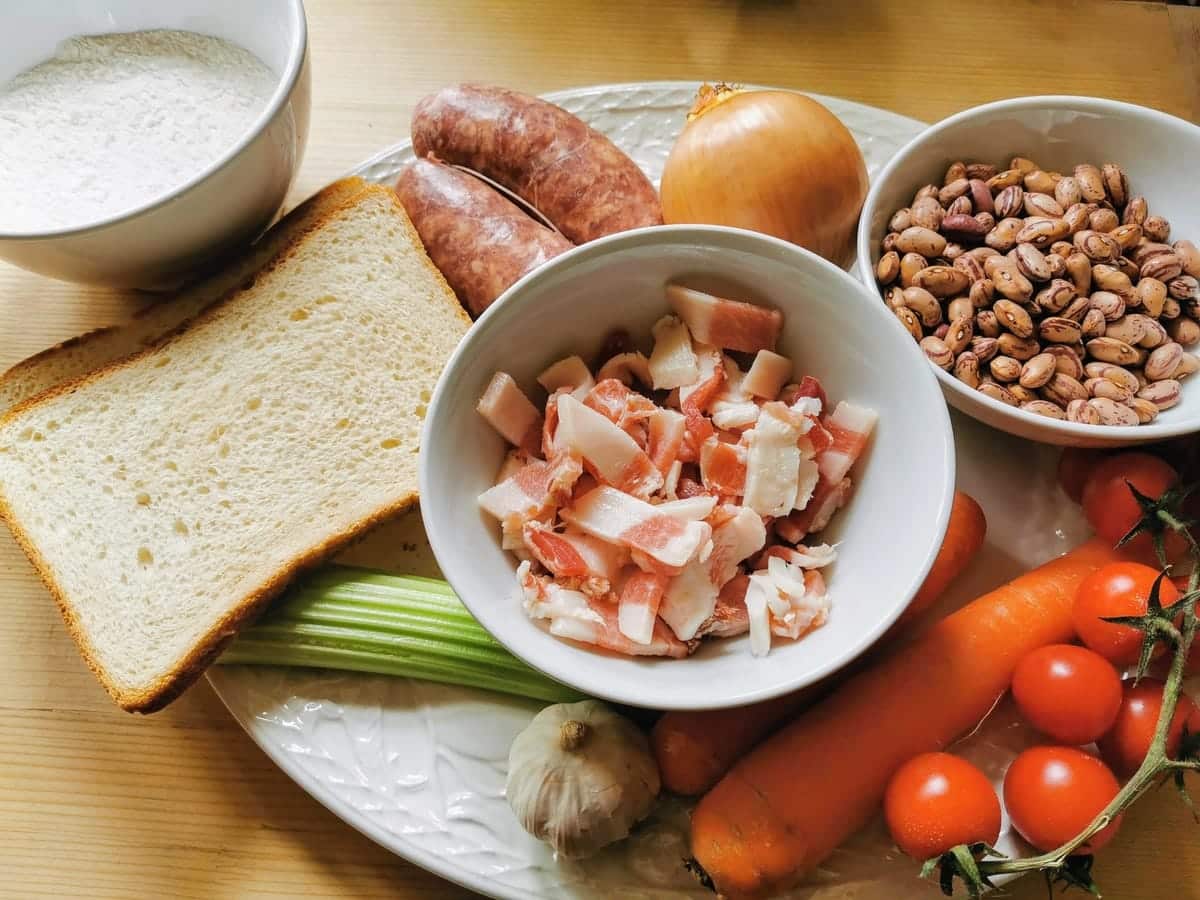
This bread gnocchi with sausage recipe can also be made with store-bought or homemade potato gnocchi if preferred.
Bread Gnocchi:
- Bread: You can use store-bought breadcrumbs or quickly blitz dried stale bread in the food processor for the bread in the gnocchi. The best type of bread to use is a thickly sliced country or rustic bread.
- Italian '00' soft wheat flour: Is a finely milled wheat flour. If unavailable, all-purpose flour can be used as a substitute.
- Salt: Important for seasoning and enhancing the gnocchi flavor.
- Warm Water: Binds the breadcrumb and flour together, creating a workable dough.
Sausage Sauce:
- Italian Pork Sausages (Salsiccia): These sausages have a distinct rich flavor. If unavailable, you can opt for mild pork sausages with the addition of some freshly chopped rosemary or crushed fennel seeds. Always remember to remove the casing and crumble the sausage meat.
- Guanciale: A traditional Italian cured meat from pork cheek. It can be substituted with pancetta or fatty bacon if unavailable.
- Onion, Celery, Carrots, & Garlic: These create the classic 'soffritto' base for the recipe.
- Tomato Passata: These are sieved tomatoes and are called tomato purée in the US. They can also be substituted for peeled and chopped fresh tomatoes.
- Borlotti Beans (Cranberry Beans): You can use either dried beans, canned beans or pre-cooked beans. If using dried beans, they should be soaked overnight and then cooked in water for about 45-60 minutes until tender.

How to make breadcrumbs from stale bread
If the bread is stale and already dried you can simply pulse the bread into breadcrumbs using a food processor. If the bread is still a little moist follow this method:
Instructions:
- Preheat Your Oven: Start by setting your oven to 200°F (93°C). This temperature will gently dry out the bread without toasting it.
- Preparation: If your bread comes with a thick crust, you might want to remove it for a uniform breadcrumb texture. Tear the bread into chunks, roughly the size of large croutons.
- Long & Gentle Drying: Lay the bread pieces evenly on a baking sheet. Let them dry out in the oven for about 15-25 minutes. The goal is to dehydrate the bread, avoiding any browning. You're aiming for a texture that's thoroughly dry and crumbly.
- Cooling Off: Ensure the bread pieces are cooled down to room temperature before proceeding.
- Grinding and Then Ready: Add the dried bread chunks into a food processor. Pulse until you get a consistent breadcrumb texture.
How to make bread gnocchi
1) Mix the breadcrumbs, flour and a teaspoon of salt together in a bowl. Slowly add the warm water while using your hands to work the ingredients into a dough.
Note: You may not need all the water or you may need to add a bit more. The dough has to be soft and slightly tacky but not wet.

2) Turn the dough out onto a pastry board and knead a little. Not a lot as otherwise your gnocchi will be too dense. Cover the dough with clingfilm (plastic wrap) and let it rest for 30-60 minutes.

3) After letting the dough rest, make the gnocchi by rolling pieces of dough into 'snakes' about 1.5 cm (0.5ins) thick and then cutting the snakes into small 1-2 cm (0.5-0.75 ins) pieces.
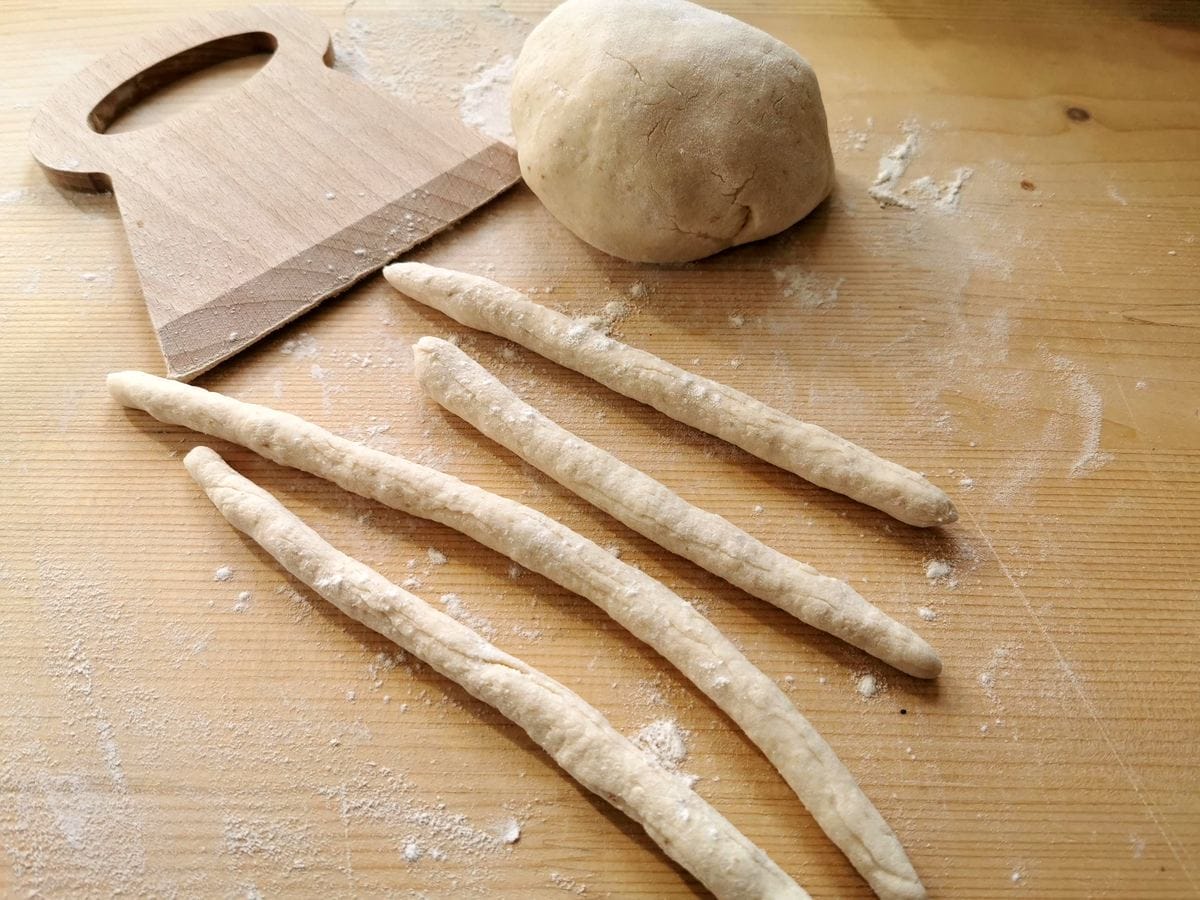
4) Put the ready gnocchi onto a tray or tea towel that’s been dusted with flour while you make the rest and the sauce.
Tip: I find semolina flour is the best for dusting.

How to make gnocchi with sausage
1) In a Dutch oven or large pot, sauté onion, garlic, celery, and carrots in olive oil over low heat. Increase the heat to medium-high, then add guanciale and sausage mince. Brown the guanciale and sausage mince this should take about 5-7 minutes.

2) After browning the meat, mix in the tomato passata and cook for an additional 15 minutes.

3) Adjust with salt, add beans, and let simmer for another 10 minutes.

4) Just before you are ready to serve, boil the breadcrumb gnocchi in salted water. As they float to the surface, move them with a slotted spoon to the sauce.
Note: Make sure to do a taste test before adding the gnocchi to the sausage sauce.

5) Mix thoroughly and serve garnished with grated pecorino.
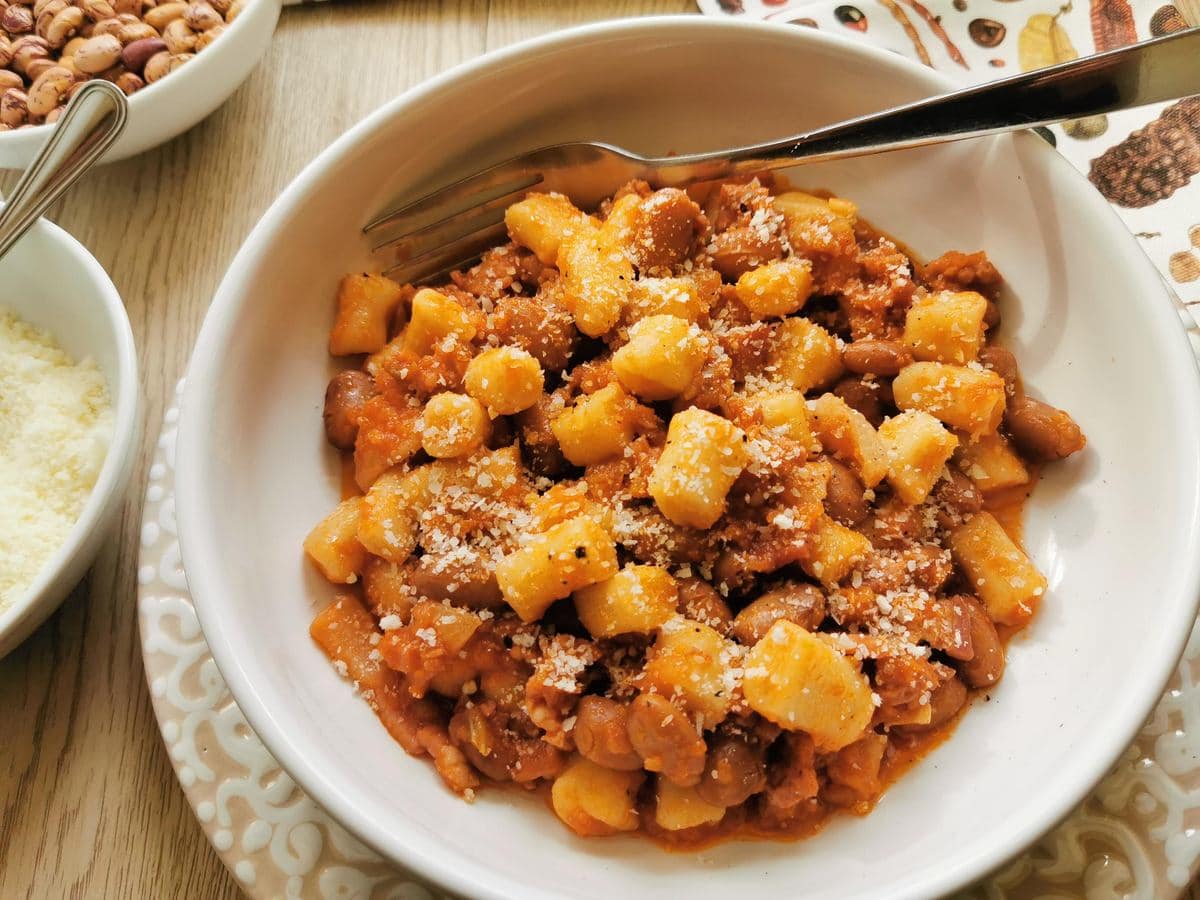
Storage and Leftovers
Storing Uncooked Bread Gnocchi: If you've prepared more gnocchi than needed, arrange them in a single layer on a tray and freeze until solid. Once firm, transfer them to a sealable bag and store them in the freezer. They'll stay fresh for up to 3 months and can be cooked directly from frozen.
Storing the Sausage Sauce: Keep any leftover sauce in a tightly sealed container. It will remain fresh in the refrigerator for up to 3-4 days. For longer storage, you can freeze it in a tightly sealed container for up to 3 months.
Reheating the Dish: When you're ready to enjoy the leftovers, slowly simmer the sauce on the stovetop. If the sauce has thickened too much, you can thin it out with a bit of water while reheating. For the uncooked gnocchi, boil them in salted water until they float to the surface, then transfer them into the sauce with a slotted spoon.
Leftovers Combined: If you have gnocchi and the sausage sauce stored together, it's best to store them in an airtight container in the refrigerator. For reheating, gently simmer on the stovetop until hot throughout, adjusting consistency if necessary with a splash of water or broth.
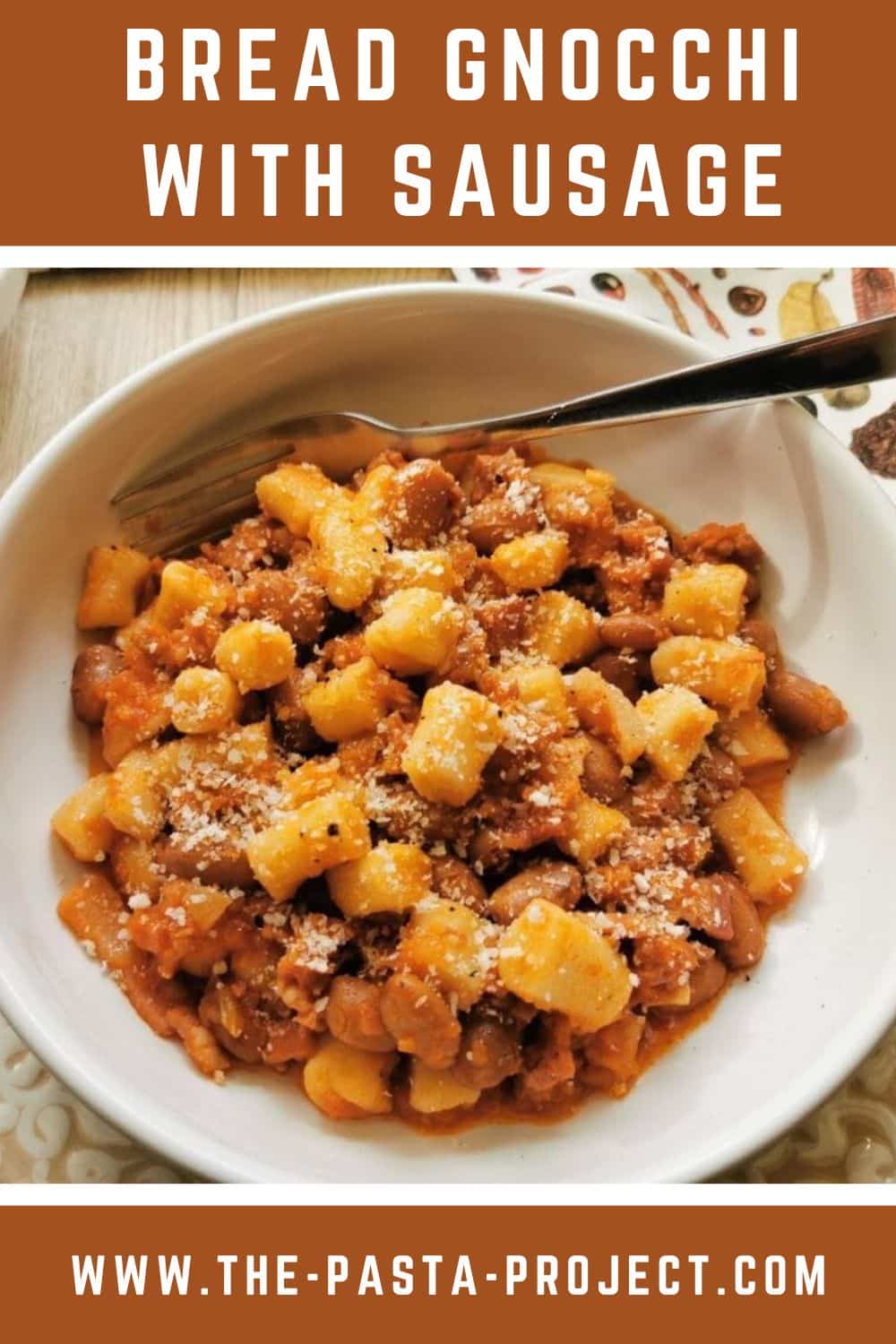
FAQs
In fact, it’s a lot less work than potato gnocchi as there’s nothing to cook beforehand. Just mix breadcrumbs, flour, salt and warm water together in a bowl until you have a dough. Then turn it out onto a pastry board and knead a little then, roll and cut.
Resting the dough allows the flour to fully hydrate and helps in relaxing the gluten strands. This ensures the gnocchi remains tender when cooked and prevents it from becoming too dense or chewy.
To prevent dense or tough gnocchi, it's essential to avoid over-kneading the dough. Over-kneading cause the gluten to tighten, leading to a tougher texture. It's also crucial to measure ingredients accurately and let the dough rest as instructed.
Stale bread is drier and crumbles more easily, making it ideal for breadcrumbs. Fresh bread contains more moisture, which can result in clumpy or uneven breadcrumbs. If you only have fresh bread on hand, you can dry it out in the oven for a similar effect.
Absolutely! The sausage sauce can be prepared a day or two in advance. In fact, allowing the sauce to sit for a while can help the flavors meld together even better. When you're ready to serve, simply reheat the sauce and then add the freshly boiled gnocchi.
More Recipes You May Like
- Pasta alla Norcina
- Pasta with Breadcrumbs
- Canederli: Italian Bread Dumplings
- Umbrian lentil soup with pasta
- Umbrian wild pea soup with pasta
If you try this bread gnocchi with sausage recipe, do please let me know what you think by commenting here on the blog or on The Pasta Project Facebook page. Your feedback is much appreciated!
Buon appetito!
SAVE THIS RECIPE FOR LATER?
If you want to save this recipe for later, you can print it, bookmark this page or save it to Pinterest.
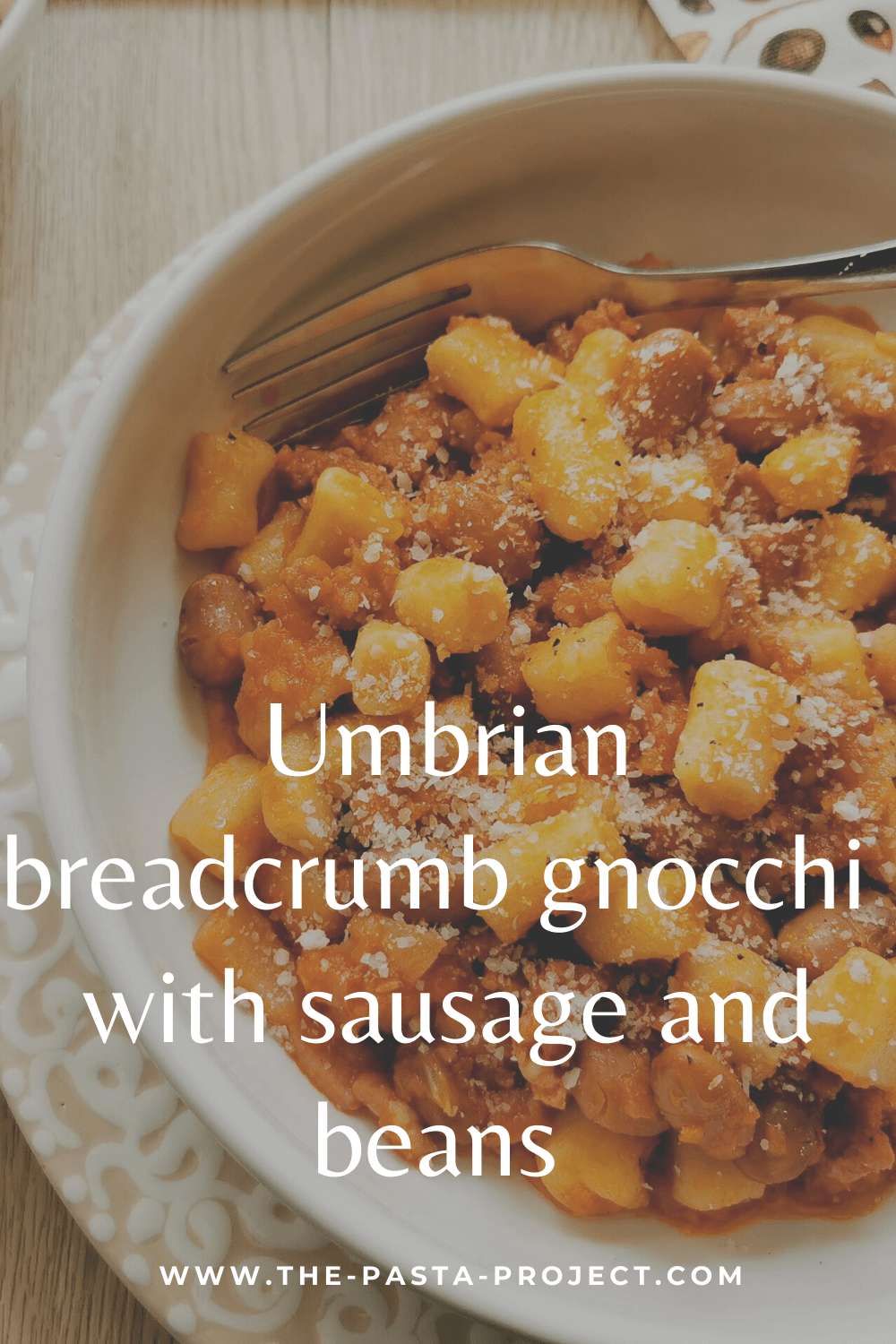
If you are interested in learning how to make homemade pasta and different types of gnocchi, check out my shop page for some great video online courses from my friends in Rome! Nothing beats learning to make pasta from Italians! Plus while you’re there why not order a copy of one of my pasta recipe cookbooks or checkout some recommended pasta making tools?
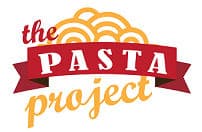

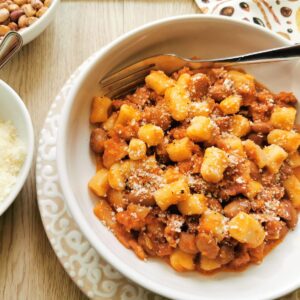

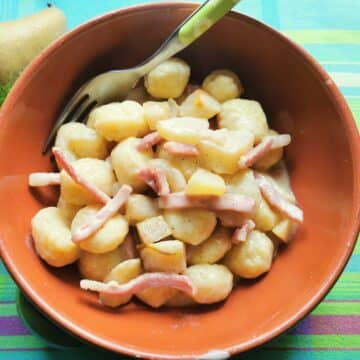

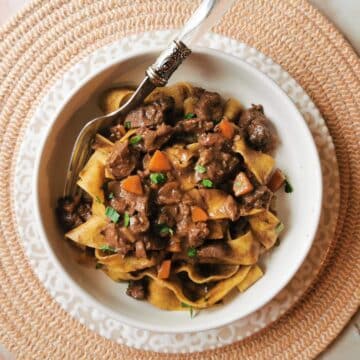

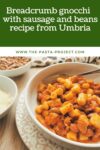
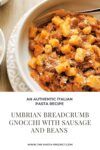
Deborah says
I had no idea you could make gnocchi from bread crumbs. I'm certainly going to try this one. It looks delicious with the sausage and beans!
Kris says
Regarding the gnocchi are these dry bread crumbs or fresh? I’m going to be making this this week and don’t want to end up with gummy gnocchi.
Jacqui says
Hi Kris. I made the breadcrumbs from stale bread, so not fresh. I'm going to correct that in the recipe to make it clearer so thanks for your comment! Do let me know how this dish turns out. I'm sure you'll enjoy it!